Abstract
Microgrids have a lot to offer, including helping smart grids operate on distribution grids or bringing electricity to some cities. The management system receives and transmits different states. This is because the elements adapt to the conditions of the network in the shortest possible time. The 5G communication technology has high transmission speed, owing to which it can improve equipment connectivity and reduce latency, allowing the real-time analysis and monitoring of electrical microgrids considerably better than earlier generations. In addition, it is estimated that, in the near future, many cities will be connected using communication systems that allow the interconnection of different systems safeguarding the connectivity, speed, and response time of these elements in an electrical system, smart grid, or microgrids with the growing development of the Internet of Things. For this reason, it is essential to analyze the integration of 5G technology to improve the management of microgrids. This literature review analyzes and presents the advantages of using 5G technologies in reducing communication latency and improving connectivity to enhance microgrids’ control and management. The active implementation of 5G in the management and control of microgrids increases the transmission and reception of data and states, reduces latency, and allows for a greater density of information, collaborating positively with resilience to the various changes that microgrids can suffer in continuous working conditions. The implementation of 5G allows electrical microgrids to be more resilient in their management and control, directly and indirectly impacting the sustainable development goals.
1. Introduction
A microgrid (MG) is a system that interconnects distributed generation sources and electrical loads [1], thus optimizing power generation. It facilitates the distribution of energy to hard-to-reach places and operates isolated from the general grid so that it can continue to generate electricity even if there is a breakdown or service outage [2,3]. It is estimated that the grid will move from mass energy production to a more distributed and closer production within several years [4].
Further, MGs can be made intelligent through various control, communication, and management technologies [5,6]. The 5G is one such technology that can improve the management of MG because it has excellent connection stability and interactions with the Internet of Things (IoT), high transmission speed, and low latency [7]. In addition, the integration of IoT into 5G results in better infrastructure within MG management that helps MG to recover from different situations due to its fast transfer speed, high reliability, robust security, low power consumption, and vast connections.
The 5G technology enhances the current status of communication networks. Similar to network speed transmission, 5G is based on high radio frequencies and can significantly reduce the response time or latency between a device and the antenna [8,9]. In addition, this technology has high data transfer rates at 4000 to 5000 megabits per second, allowing it to perform some services more efficiently and in less time [10]. Therefore, it is viewed as a complementary technology that extends traditional wired infrastructure such as fiber optics [11,12].
Implementing 5G technology in MGs can regulate services between smart grids by controlling resources on demand through innovative and improved communication. In addition, this technology aids in developing and applying MGs that contribute to developing smart grids [13]. Integrating smart grids and microgrids in electrical power systems allows the development of Sustainable Development Goals (SDG7) [14], in addition to improving the adequacy of the control and communications infrastructure, achieving (SDG9) [15].
Considering those mentioned earlier, the objective of this article is to present methodological analyses of the impact of implementing 5G technologies in the management and control of MGs.
The main contributions of this paper in this field of research are:
- Literature review of the impacts of 5G technology when integrated into electrical MGs’ management and control strategy.
- Analysis of the 5G technology performance compared to previous generation technologies when applied to MGs.
- Future research opportunities and gaps in the use of 5G technology for control and management of electrical MGs.
This article reviews the literature on the utilities provided by 5G technology for the real-time management of electrical MGs. With the help of information and communications technology, the 5G technology integrated with MGs minimizes latency and expands its applications. This article presents the methodology used for conducting this review and the applications of both MGs and 5G technology. We also present a discussion section where we discuss our findings and provide concluding remarks in the conclusion section.
2. Methodology
The methodology used in this study is given below:
- Search for articles: First, we performed an exhaustive search based on MG terminologies and 5G technology. The keywords were searched within titles and abstracts: MG, 5G, communication protocols, energy management, distributed systems, and wired networks. Connectors such as “AND” and “OR” were used along with the keywords to improve the search scope. Figure 1 demonstrates the results obtained using the exact keywords in different sources of information.
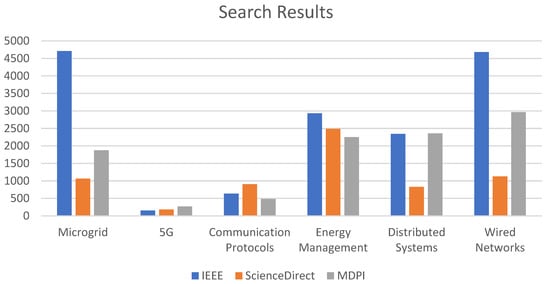 Figure 1. Search results in different sources of information.
Figure 1. Search results in different sources of information. - Filtering of articles: After obtaining a list of studies based on keyword search, three filters were applied to retain only those studies that are relevant to the subject. The first filter used only search engines from reliable sources (IEEE, ScienceDirect, and MDPI) based on the unique and permanent identifier for electronic publications (DOI). Then, a chronological second filter was applied to the results from the first filter by selecting studies published between 2016 and 2022 because most of the research work on implementing 5G within MGs was published within this period.
- Filtering coincidences: In the last filter, the logical AND combination of the keywords shown in Figure 2 was used in the search exclusively within the title or the abstract. Accordingly, the initial search result of 26,640 was reduced to the 125 articles considered in this review.
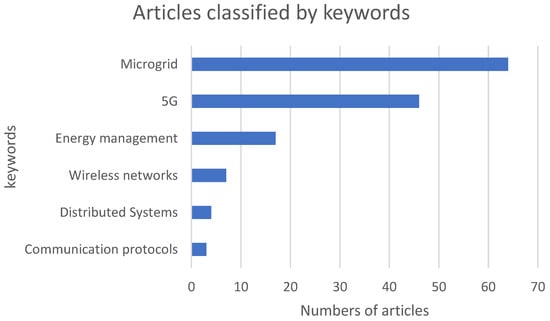 Figure 2. Filtering with keywords.
Figure 2. Filtering with keywords. - Analysis of results: The gaps in the research were considered as the base for this present review providing the current situation of the use of 5G within MGs.
3. MGs in the Electricity Sector
An MG is an emerging small-scale energy system comprising distributed energy resources, solar photovoltaics, wind generators, microturbines, and energy storage systems [16].
Figure 3 presents the flow of energy and information in the grid and MG. Here, it should be noted that the energy flow between the MG and the power grid is bidirectional. The status elements that conform to the grid network and the MG are sent through communications systems.
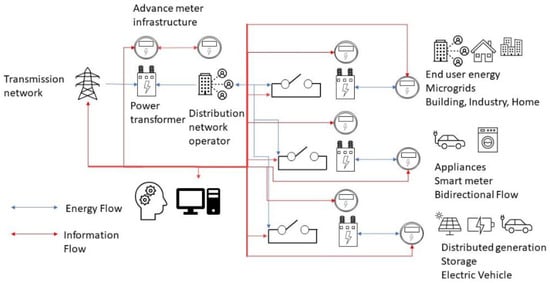
Figure 3.
Flow of energy and information in the grid and microgrid.
Researchers have developed and revised the MGs’ electrical parameters configurations [17,18].
The MGs offer many advantages, such as their ability to regulate between complementary services to the grid, automatic operation, and better quality of energy in the supply of services [19,20]. However, microgrids also have some disadvantages that should be considered as well. They are more complex protection systems, require energy to be stored in battery banks, and constantly regulate the parameters to deliver quality energy of acceptable standards [21,22].
Figure 4 compares the parameters of a conventional electrical grid and that of an MG.
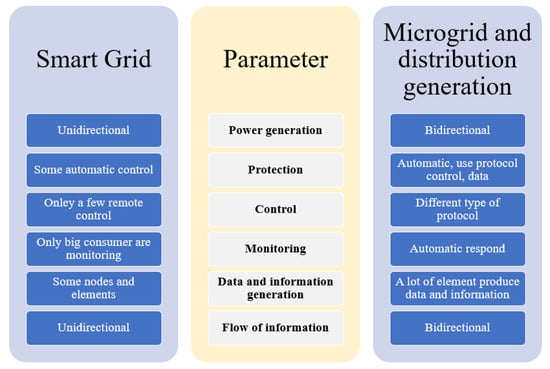
Figure 4.
Comparison of communications systems in microgrids and smart grids.
Furthermore, MGs can be classified according to their focus, scope, or purpose. The configurations that can be applied in the microgrid are presented in [23,24].
Microgrid Management
An MG operation is generally flexible because it can work with the grid. It allows power supplies to be more reliable than compact systems since, in case of failures or accidents, the power levels decrease, preventing them from being completely isolated.
In addition, autonomous MGs require greater attention in operation than interconnected ones. Thus, highly efficient management is essential to obtain the best results in areas covered by autonomous MGs.
Integrating MGs into low-voltage electricity grids (conventional or smart grids) allows for better demand-side management and demand-side renewable energy resources, enabling an operation that only depends on conventional energy services.
4. MG Communications
Proper communication between all controllers can optimize the operation of the entire MG system [25]. Information and communication technologies (ICTs) facilitate the execution of MG control and protection strategies, thus enabling interoperability between the other components of the MG. The type, scalability, and interoperability of the ICT infrastructure affect the operation of an MG control system [26,27].
Data networks can be categorized into home area networks (HANs), neighborhood area networks (NANs), and wide area networks (WANs). Each network can be applied in conventional, smart, and MGs. These networks facilitate the interconnection of household appliances, smart meters, or other equipment that must be online in a communication network. NAN connects power and voltage bus substations with smart meters; in other words, the NAN interconnects several HANs. WAN interconnects several NANs and serves as interconnection points between the power control center gateway, transmission lines, power plants, and distribution network operators [28].
The size of the microgrid and the elements that conform to the MG determine the complexity of the MG. In addition, its number of nodes and the network structure’s complexity will increase the communication system’s data traffic [29].
The application of ICT in electricity grids enables bidirectional information and energy flows, resulting in grid-interconnected renewable energy systems [30].
Communication in MGs depends on the difficulty level of these energy systems and their requirements [31]. Nevertheless, a modern MG has a multilevel communication system that involves different factors such as operations, customers, distribution systems, transmission, market, and generation systems, as shown in Figure 5.
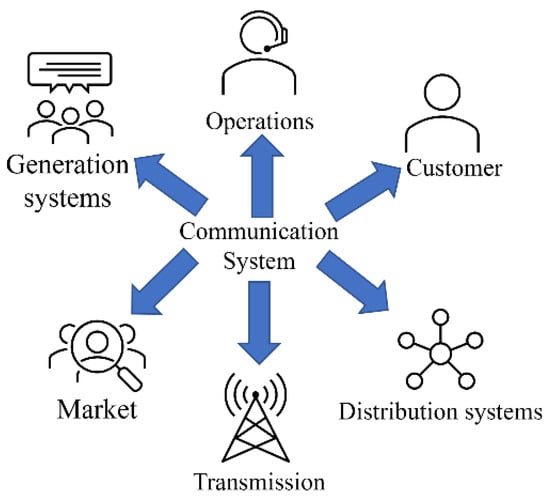
Figure 5.
Modern multilevel communication microgrid.
Researchers [26,27,32,33,34,35] have shown the different applications of electrical MGs and communication systems and their respective protocols that allow interoperability between all the system elements for MGs using 5G technology. For intelligent metering, nodes within MGs use TCP-IP/NB-PLC/TCP/IP protocols. IEC 61850 standard, Modbus, or DNP3 protocols are used for microgrid control and management.
Specific fundamental points within the infrastructure of the communication system in the MG should be taken into account for their correct functioning because they have an optimal level [36]. In addition, the following aspects should also be considered:
Security: The interdependence between the electrical system and the communication network in the smart grid makes its reliability, operation, and safety issues more complex than in the traditional power grid [37]. Thus, reliability assessment studies should include the impact of communication data, as classical deterministic contingency analysis is insufficient for such assessment [38]. Some researchers have also stated the effectiveness of machine learning methods in detecting attacks with a detection accuracy greater than 95% [39].
Latency: The delay time in transmitting information in any information network is called latency. It can result in momentary or temporary loss of information within a data network. Some causes of latency include server congestion, the weight of information to be transmitted, and characteristics of the contracted internet service [40,41].
A critical requirement for touch applications in high-quality communication within MGs is low latency because it requires a low end-to-end delay in control messages [42]. The latency requirements of a communication network are determined by the selected locations of the communication entities and the implemented transmission technology [43].
Figure 6 shows that latency decreases when the technology is more updated. Therefore, the lower the latency, the more significant the number of components that can be added to the system. In addition, the decrease in latency increases data sampling, enabling the operators of the data acquisition system to respond faster in the case of protections.

Figure 6.
Data collection speed by technology.
Data delivery: MGs’ power supply system operation requires high-speed data [44]. The MG control system receives and analyzes these high-speed data and then sends a control signal before the following dataset for processing [45].
Reliability: This is essential in the power supply system in MGs. This is because power converter failure can interrupt the power supply, resulting in a significant increase in the cost of system operation [46]. Thus, researchers proposed an algorithm to improve MG reliability, where the operating state of each MG can be sampled simultaneously. This algorithm also considers the interaction between various MGs in a multi-MG system [47,48].
Scalability: An essential competency of MGs is their ability to continue operating efficiently with the increased number of nodes. In some cases, the secure communication system uses a flexible control structure consisting of a local subsystem controller, a flexible controller that performs a higher level of control, and an MG central controller [49].
Broadband: MG communication involves limited bandwidth, although there is a continuous frequency of controller updates for comparisons with a feedback control over time [50]. However, when multiple levels of control are used, it may involve more significant bandwidth communication deficiencies [51].
4.1. Applications of 5G Technology in MGs
The 5G is the most advanced wireless communication technology with broad applications in smart industries, smart cities, and health [52,53]. The fifth generation of mobile networks facilitates communication with ultralow latency and high data transfer rate [54].
Many researchers worldwide are interested in the applications of 5G communication in MG technology to implement different solutions to problems in developing MGs. Table 1 presents a list of studies that propose solutions to the different adversities arising in MG technology:

Table 1.
Article contributions to 5G microgrid deployments and their limitations.
The new generation of communication networks has several features, such as data transfer of 1–10 gigabits per second (Gbps), high bandwidth, ultralow latency, reliable connection between devices, mass communication between machines, high energy efficiency, simultaneous redundancy, and a prosumer [62]. Figure 6 presents a comparison of three types of networks.
Figure 7 shows that all technologies have “scalability”, which refers to the ability of networks to increase in size when the number of nodes increases, and its reaction to the constant increase in workflow [63].
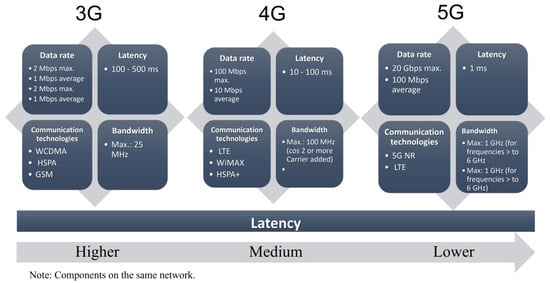
Figure 7.
Comparison of network groups.
Compared to previous technologies transmitted by long-distance antennas, 5G is transmitted using many small antennas placed on the roofs of buildings or light poles because of the frequency spectrum in which they travel [64].
The 5G technology has many advantages, including higher data transfer speed, IoT-enabled technology, and energy consumption savings of up to 90% [65]. However, its disadvantages include its low capacity to cross obstacles, limited availability of 5G-compatible devices in the market, and expensive spectrum bands of the network [66].
The development of 5G technology provides a broader basis for the energy system, such as bilateral energy business, dynamic energy pricing, and active wireless transmission spectra between the MG and the network [67,68].
The 5G technology is being increasingly used in energy systems [69]. It can incorporate the following business needs depending on the performance characteristics [70]:
- Intelligent power distribution automation to obtain coordinated and automated system protection control.
- Collection of low-voltage power information, charging station/smart car battery, and distribution of crucial terminal access requirements for uplink services of information collection type, such as access to the power supply.
- Monitoring the status of power transmission and distribution systems, video calls, high-definition return phones, an electrical system inspection through remote supervision, and emergency communication.
- Millisecond-precision load control detects faults in the electrical network in real time, integrates various types of power supplies, and performs coordinated control of all equipment in the network.
- It ensures the reliability of differential protections and low latency of the active distribution network to protect industrial control downlink services.
4.2. MG Configurations with 5G Technologies
Traditionally, MG configuration involves determining the optimal configuration of system power, type, and size of installed generators to meet load requirements at a minimal cost. An essential aspect of the MG planning and design stage is configuring distributed generation capacity [71]. In order to meet the diverse needs of users and cover unexpected events, and ensure system reliability, devices must be reasonably configured [72]. MGs can be optimally configured using optimizers based on models proposed according to requirements [73].
Hybrid algorithms have been developed to create optimal reconfiguration of grids in the distribution network in the presence of distributed generation resources [74]. In a hybrid algorithm, the generation node and the load node interact in real time and can assist in dynamic system modeling to minimize performance losses in the network [75].
At the time of configuration, the type of MG energy production should be considered due to the uncertainties associated with renewables, especially for what should be considered during the MG planning period [76]. Power electronics are sometimes integrated with 5Gs to have fewer functional transmissions, permanently creating a sleep time of less than 1 ms and reducing latency and power consumption. It is also used to facilitate the distribution within MGs. Table 2 presents an example of a microgrids use 5G for control, and Table 3 presents microgrids use 5G management applications.

Table 2.
Some microgrids use 5G for control.

Table 3.
Some microgrids use 5G management applications.
4.3. Implementation Cases
In some cases, the researchers briefly explained the research on 5G implementation in MG technology. These research works served as pilot schemes for this study.
- Renewable Energies
Facilities need to be expanded, and power generation efficiency needs to improve to increase the participation of renewable energy technology in the power system. The abovementioned can be achieved by operating and managing existing facilities. These problems can be solved by integrated control and management of new and renewable power generation facilities using the Internet of Energy. The necessary energy capacity using renewable energy can be maintained using fault detection technologies with remote monitoring. The above also allows renewable energy maintenance of the necessary energy capacity [55].
- Energy Storage System
The energy storage system was built based on the energy management of buildings and industries, where standardization works as peak control, renewable energy stabilization, frequency adjustment, and grid control [56].
- Electric Vehicle Charging
The 5G networks and the standard hierarchical architecture facilitate using distributed energy resources (micro- or nanogrids, vehicles, and others). The previous can lead to an optimal transaction between consumer and producer using lightweight, low-latency communication protocols. In this way, users can adopt the position of consumers and producers [89].
- Teleprotection electrical systems
Coordination of protections is critical in the grid, smart grid, and MGs. In addition, communications systems allow sending and receiving information with the lowest possible latency and in the shortest time, achieving correct coordination between the elements of protection in the grid [58]. There is a demand for a real-time data exchange that can only be achieved using new communications networks by integrating intelligent electronic devices, IoT equipment, smart metering, teleprotections, and grid controllers [90].
5. Discussion
The use of 5G technologies in MGs is associated with a decrease in latency and lower power consumption, offering excellent connectivity between devices, among other things. This technology positively impacts the management of electrical MGs as it improves their efficiency and allows real-time monitoring and control. However, the investment and maintenance costs are very high for this system, which is only for the management part with 5G technology.
The 5G technology brings significant changes in the digital space and positively impacts smart cities. It increases the development and implementation of smart cities, improving data transfer speeds and reducing the response time of systems. It allows the creation of resilient electrical systems proposed by the sustainable development objectives.
Shortly, 5G technology will become the basis of digital and industrial transformation. However, to efficiently utilize this technology, cities must improve in other aspects, such as technology and their policies on their ecosystem and business, due to the high investment cost of this system.
In today’s scenario, only a handful of countries can integrate or develop an MG with renewable generation systems and 5G technologies. This is because of the limitations associated with 5G technology. These limitations include the cost of 5G infrastructure, deployment of fiber optics for data transport, radio spectrum management, and energy backup systems.
However, the 5G mobile network shows a significant advantage over previous technologies because of its high transfer speed, low latency, and higher bandwidth. These features allow the better management of renewable and nonrenewable energy resources and the interconnected demand of the MG. In addition, the speed in communications is essential in teleprotection, especially in the differential of lines. Generally, a trip transferred from one substation to another must arrive in 4 ms. Therefore, in some cases, the current measurements of these substations are connected by fiber optics. However, the use of 5G in these cases can not only achieve the required level but also save the fibers.
As shown in Figure 8, different researchers proposed the integration of 5G together with smart cities, MGs, and industry. In the case of smart cities, the integration system is proposed to be under constant monitoring of the use of electricity by the end user in real time. It can be achieved by using smart meters with free access to this consumption for both the distributor and users, regardless of the type of services they consume.
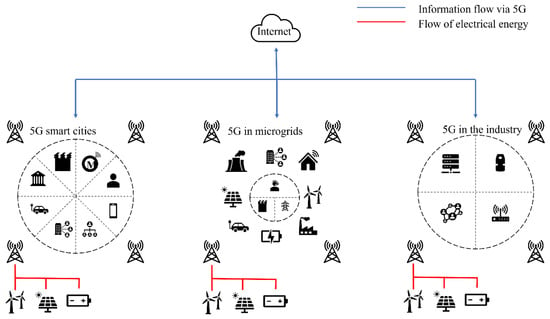
Figure 8.
5G applications within the microgrid.
The use of intelligent sensors is stipulated within the production processes to have precise control over a situation; the control center acts, while application servers control the actuators of the different stages of production. This solution facilitated dynamic changes with a shorter downtime for changes. Thanks to its low latency, reference is made to the integration of 5G as a data transport route.
In the case of MGs, the use of technologies provided by 5G proposed continuous network analysis. Accordingly, consumption and demand could be actively analyzed, giving way to an acceptable response time to network changes. In another vein, some researchers refer to this as conferring additional resilience, creating a new layer of security against possible attacks or eventualities within the MG, regardless of its nature. Although cybersecurity would pose a considerable challenge to the successful implementation of 5G technologies, further research must also be conducted.
Integrating 5G technology within these systems requires base stations with a large electrical energy consumption. Therefore, some researchers proposed using alternative energies to be more environmentally friendly. Figure 8 refers to using renewable energy to power these base stations, considering wind energy, photovoltaics, and a good storage system.
As shown in Figure 9, a conglomerate of TCP/IP model protocols is categorized based on their application layer. These protocols have different applications depending on their applicability. Each of them are communications protocols focused on controlling and monitoring MGs.
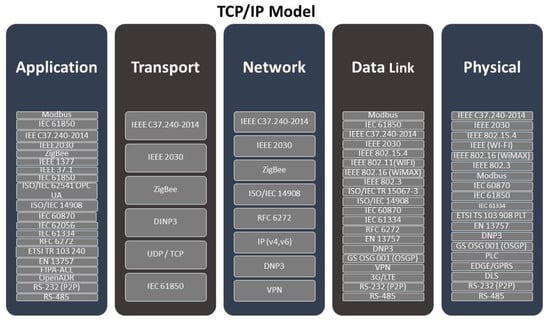
Figure 9.
Communication protocols based on TCP/IP model.
6. Conclusions
This review examines the status of MG deployment alongside 5G technology and explores its use in renewable resource management and interconnected energy demand. The findings of this study will allow other interested researchers or readers to expand their knowledge on this topic and will provide different projects carried out in other countries.
At present, MGs are being integrated into interconnected systems. Therefore, the response of the MG must be in real time to determine the exact demand for decision making and actions; thus, 5G can effectively collaborate in managing them.
Through regulatory bodies, countries must begin to utilize 5G technology efficiently. When the necessary resources are available, researchers and organizations will soon start generating projects for field studies or start-up experiments in real MGs.
A literature review showed that different authors referred to using renewable energies to power the stations necessary for implementing 5G. It indicates that they propose using renewable energies to reduce carbon footprint as these facilities demand very high energy. It also allows greater penetration of distributed generation, smart grids, and microgrids in power systems since management, control, and teleprotection will have a reduced delay time, allowing it to be the most resilient power system and reach SDGs 7 and 9.
It should be noted that there is a lack of sufficient literature on the subject, indicating the lack of exploration on this topic and limited field studies, as it is a recently developed field. That is why there is motivation to investigate the creation of knowledge, although it is true that it is a new field in development with great strengths that position it as an emerging promise in the use of MG management.
Author Contributions
Conceptualization, A.J.T.C. and M.A.-M.; methodology, A.J.T.C. and M.A.-M.; writing—original draft preparation, M.A.-M. and Y.D.R.; writing—review and editing, A.J.T.C., K.C.R., J.G.D., D.R.W., and M.A.-M.; supervision, M.A.-M., D.M.-H., Y.D.R., and L.H.-C. All authors have read and agreed to the published version of the manuscript.
Funding
This research was funded by Fondocyt Grant No. 2018-2019-3C1-160 (055-2019 INTEC) in the Dominican Republic.
Data Availability Statement
Not applicable.
Conflicts of Interest
The authors declare no conflict of interest.
Abbreviations
| MG | Microgrid |
| USDOE | US Division of Energy |
| LAN | Local Area Network |
| WAN | Wide Area Network |
| EMS | Energy Management Systems |
| PI | Proportional–integral controllers |
| ANFIS | Neuro-diffuse adaptive inference system |
| DMS | Demand management system |
| DR | Demand response |
| AMI | Advance Meter Infrastructure |
| MDM | Meter Data Management |
| PMU | Phasor units of measurement |
| ESS | Energy storage system |
| ULL | Ultralow latency |
| IoE | Internet of Energy |
| ICT | Information and communication technologies |
| SCADA | Supervisory control and data acquisition |
| MQTT | Message Queuing Telemetry Transport |
| XMPP | Extensible messaging and presence protocol |
| AMQP | Advanced Message Queuing Protocol |
| TCP | Transmission Control Protocol |
| UDP | User Datagram Protocol |
| DSRC | Dedicated short-range communications |
| NCS | Network-based call signal |
References
- Shams, M.H.; Shahabi, M.; Kia, M.; Heidari, A.; Lotfi, M.; Shafie-Khah, M.; Catalão, J.P. Optimal operation of electrical and thermal resources in microgrids with energy hubs considering uncertainties. Energy 2019, 187, 115949. [Google Scholar] [CrossRef]
- Peker, M.; Kocaman, A.S.; Kara, B.Y. A two-stage stochastic programming approach for reliability constrained power system expansion planning. J. Electr. Power Energy Syst. 2018, 103, 458–469. [Google Scholar] [CrossRef]
- Gómez, V.A.; Hernández, C.; Rivas, E. Visión General, Características y Funcionalidades de la Red Eléctrica Inteligente (Smart Grid). Inf. Tecnol. 2018, 29, 89–102. [Google Scholar] [CrossRef]
- Villada Sandoval, P.A. Diseño y Simulación de una Micro-Red Eléctrica Aislada Basada en el Uso de Fuentes de Energía Renovable; Universidad Santo Tomás: Manila, Philippines, 2020. [Google Scholar]
- Batista Fuentes, M.E.; Díaz Ibáñez, E.K. Tecnología móvil 5G. Mare Ingenii 2019, 1, 65–72. [Google Scholar] [CrossRef]
- Novillo-Vicuña, J.; Hernández Rojas, D.; Mazón Olivo, B.; Molina Ríos, J.; Cárdenas Villavicencio, O. Arduino y el Internet de las Cosas, 1st ed.; Editorial Científica Ciencias: Madrid, Spain, 2018. [Google Scholar]
- Porcu, D.; Chochliouros, I.P.; Castro, S.; Fiorentino, G.; Costa, R.; Nodaros, D.; Koumaras, V.; Brasca, F.; di Pietro, N.; Papaioannou, G.; et al. 5G Communications as “Enabler” for Smart Power Grids: The Case of the Smart5Grid Project. In Artificial Intelligence Applications and Innovations. AIAI 2021 IFIP WG 12.5 International Workshops; Maglogiannis, I., Macintyre, J., Iliadis, L., Eds.; Springer International Publishing: Cham, Switzerland, 2021; pp. 7–20. [Google Scholar]
- Sanduleac, M.; Chimirel, C.; Paun, M. PMU Orchestrator as a Solution for Managing Microgrid Monitoring with 5G Communication. In Proceedings of the 2019 54th International Universities Power Engineering Conference (UPEC), Bucharest, Romania, 3–6 September 2019. [Google Scholar]
- Ahmed, M.; Meegahapola, L.; Vahidnia, A.; Datta, M. Stability and Control Aspects of Microgrid Architectures–A Comprehensive Review. IEEE Access 2020, 8, 144730–144766. [Google Scholar] [CrossRef]
- Shih, X.-Y.; Huang, P.-C.; Chou, H.-R. VLSI design and implementation of a reconfigurable hardware-friendly Polar encoder architecture for emerging high-speed 5G system. Integration 2018, 62, 292–300. [Google Scholar] [CrossRef]
- Kawanishi, T.; Kanno, A.; Freire, H.S. Wired and Wireless Links to Bridge Networks: Seamlessly Connecting Radio and Optical Technologies for 5G Networks. IEEE Microw. Mag. 2018, 19, 102–111. [Google Scholar] [CrossRef]
- Flammini, A.; Ferrari, P.; Marioli, D.; Sisinni, E.; Taroni, A. Wired and wireless sensor networks for industrial applications. Microelectronics J. 2009, 40, 1322–1336. [Google Scholar] [CrossRef]
- Naqvi, N.; Rehman, S.U.; Islam, M.Z. A Hyperconnected Smart City Framework: Digital Resources Using Enhanced Pedagogical Techniques. Australas. J. Inf. Syst. 2020, 24, 1–42. [Google Scholar] [CrossRef]
- Kumar, N.M.; Chopra, S.S.; Chand, A.A.; Elavarasan, R.M.; Shafiullah, G.M. Hybrid Renewable Energy Microgrid for a Residential Community: A Techno-Economic and Environmental Perspective in the Context of the SDG7. Sustainability 2020, 12, 3944. [Google Scholar] [CrossRef]
- Palomares, I.; Martínez-Cámara, E.; Montes, R.; García-Moral, P.; Chiachio, M.; Chiachio, J.; Alonso, S.; Melero, F.J.; Molina, D.; Fernández, B.; et al. A panoramic view and swot analysis of artificial intelligence for achieving the sustainable development goals by 2030: Progress and prospects. Appl. Intell. 2021, 51, 6497–6527. [Google Scholar] [CrossRef] [PubMed]
- Villanueva-Rosario, J.A.; Santos-García, F.; Aybar-Mejía, M.E.; Mendoza-Araya, P.; Molina-García, A. Coordinated ancillary services, market participation and communication of multi-microgrids: A review. Appl. Energy 2022, 308, 118332. [Google Scholar] [CrossRef]
- Espina, E.; Llanos, J.; Burgos-Mellado, C.; Cárdenas-Dobson, R.; Martínez-Gómez, M.; Sáez, D. Distributed Control Strategies for Microgrids: An Overview. IEEE Access 2020, 8, 193412–193448. [Google Scholar] [CrossRef]
- Aybar-Mejía, M.; Villanueva, J.; Mariano-Hernández, D.; Santos, F.; Molina-García, A. A Review of Low-Voltage Renewable Microgrids: Generation Forecasting and Demand-Side Management Strategies. Electronics 2021, 10, 2093. [Google Scholar] [CrossRef]
- Beheshtaein, S.; Cuzner, R.; Savaghebi, M.; Guerrero, J. Review on microgrids protection. IET Gener. Transm. Distrib. 2019, 13, 743–759. [Google Scholar] [CrossRef]
- Wang, X.; Wang, H.; Ahn, S.-H. Demand-side management for off-grid solar-powered microgrids: A case study of rural electrification in Tanzania. Energy 2021, 224, 120229. [Google Scholar] [CrossRef]
- Aros-Vera, F.; Gillian, S.; Rehmar, A.; Rehmar, L. Increasing the resilience of critical infrastructure networks through the strategic location of microgrids: A case study of Hurricane Maria in Puerto Rico. Int. J. Disaster Risk Reduct. 2021, 55, 102055. [Google Scholar] [CrossRef]
- Ju, Y.; Gao, Z.; Li, Z.; Chen, X.; Zhen, J. A review on transient stability of land-sea networked fishery microgrids. Inf. Process. Agric. 2021, 9, 148–158. [Google Scholar] [CrossRef]
- Al-Ismail, F.S. DC Microgrid Planning, Operation, and Control: A Comprehensive Review. IEEE Access 2021, 9, 36154–36172. [Google Scholar] [CrossRef]
- Nejabatkhah, F.; Li, Y.W.; Tian, H. Power Quality Control of Smart Hybrid AC/DC Microgrids: An Overview. IEEE Access 2019, 7, 52295–52318. [Google Scholar] [CrossRef]
- Alam, M.N.; Chakrabarti, S.; Ghosh, A. Networked Microgrids: State-of-the-Art and Future Perspectives. IEEE Trans. Ind. Inform. 2019, 15, 1238–1250. [Google Scholar] [CrossRef]
- González, I.; Calderón, A.J.; Portalo, J.M. Innovative Multi-Layered Architecture for Heterogeneous Automation and Monitoring Systems: Application Case of a Photovoltaic Smart Microgrid. Sustainability 2021, 13, 2234. [Google Scholar] [CrossRef]
- Habib, H.F.; Fawzy, N.; Esfahani, M.M.; Mohammed, O.A.; Brahma, S. An Enhancement of Protection Strategy for Distribution Network Using the Communication Protocols. IEEE Trans. Ind. Appl. 2020, 56, 1240–1249. [Google Scholar] [CrossRef]
- Ali, W.; Ulasyar, A.; Mehmood, M.U.; Khattak, A.; Imran, K.; Zad, H.S.; Nisar, S. Hierarchical Control of Microgrid Using IoT and Machine Learning Based Islanding Detection. IEEE Access 2021, 9, 103019–103031. [Google Scholar] [CrossRef]
- Fusheng, L.; Ruisheng, L.; Fengquan, Z. Communication of the microgrid. Microgrid Technol. Eng. Appl. 2016, 53, 115–124. [Google Scholar] [CrossRef]
- Alsalloum, H.; Merghem-Boulahia, L.; Rahim, R. Hierarchical system model for the energy management in the smart grid: A game theoretic approach. Sustain. Energy Grids Netw. 2020, 21, 100329. [Google Scholar] [CrossRef]
- Lien, K.-Y.; Bui, D.M.; Chen, S.-L.; Zhao, W.-X.; Chang, Y.-R.; Lee, Y.-D.; Jiang, J.-L. A novel fault protection system using communication-assisted digital relays for AC microgrids having a multiple grounding system. Int. J. Electr. Power Energy Syst. 2016, 78, 600–625. [Google Scholar] [CrossRef]
- Starke, M.; Herron, A.; King, D.; Xue, Y. Implementation of a Publish-Subscribe Protocol in Microgrid Islanding and Resynchronization with Self-Discovery. IEEE Trans. Smart Grid 2017, 10, 361–370. [Google Scholar] [CrossRef]
- Harmon, E.J.; Ozgur, U.; Cintuglu, M.H.; de Azevedo, R.; Akkaya, K.; Mohammed, O.A. The Internet of Microgrids: A Cloud-Based Framework for Wide Area Networked Microgrids. IEEE Trans. Ind. Inform. 2017, 14, 1262–1274. [Google Scholar] [CrossRef]
- Han, Y.; Zhang, K.; Li, H.; Coelho, E.A.A.; Guerrero, J.M. MAS-Based Distributed Coordinated Control and Optimization in Microgrid and Microgrid Clusters: A Comprehensive Overview. IEEE Trans. Power Electron. 2017, 33, 6488–6508. [Google Scholar] [CrossRef]
- Kermani, M.; Adelmanesh, B.; Shirdare, E.; Sima, C.A.; Carnì, D.L.; Martirano, L. Intelligent energy management based on SCADA system in a real Microgrid for smart building applications. Renew. Energy 2021, 171, 1115–1127. [Google Scholar] [CrossRef]
- Ali, I.; Hussain, S.M.S. Communication Design for Energy Management Automation in Microgrid. IEEE Trans. Smart Grid 2016, 9, 2055–2064. [Google Scholar] [CrossRef]
- Cai, Y.; Cao, Y.; Li, Y.; Huang, T.; Zhou, B. Cascading Failure Analysis Considering Interaction Between Power Grids and Communication Networks. IEEE Trans. Smart Grid 2015, 7, 530–538. [Google Scholar] [CrossRef]
- Siqueira De Carvalho, R.; Mohagheghi, S. Impact of communication system on smart grid reliability, security and operation. In Proceedings of the 2016 48th North American Power Symposium (NAPS), Denver, CO, USA, 18–20 September 2016. [Google Scholar] [CrossRef]
- Dai, S.; Chi, Y.; Qiao, Z.; Ji, X. A microgrid controller security monitoring model based on message flow. In Proceedings of the 2020 2020 IEEE 4th Conference on Energy Internet and Energy System Integration (EI2), Wuhan, China, 30 October–1 November 2020; pp. 3822–3826. [Google Scholar]
- Mantilla Jaramillo, F.K. Medición de Latencias de Internet con Servidores Internacionales de Clientes de la Corporación Nacional de las Telecomunicaciones (Cnt) en La Central Zonal 5. Bachelor’s Thesis, Universidad Católica de Santiago de Guayaquil, Guayaquil, Ecuador, 2019. [Google Scholar]
- Briscoe, B.; Brunstrom, A.; Petlund, A.; Hayes, D.; Ros, D.; Tsang, I.-J.; Gjessing, S.; Fairhurst, G.; Griwodz, C.; Welzl, M. Reducing Internet Latency: A Survey of Techniques and Their Merits. IEEE Commun. Surv. Tutor. 2014, 18, 2149–2196. [Google Scholar] [CrossRef]
- Elsayed, M.; Erol-Kantarci, M. Deep Q-Learning for Low-Latency Tactile Applications: Microgrid Communications. In Proceedings of the 2018 IEEE International Conference on Communications, Control, and Computing Technologies for Smart Grids (SmartGridComm), Aalborg, Denmark, 29–31 October 2018. [Google Scholar]
- Katsaros, K.V.; Yang, B.; Chai, W.K.; Pavlou, G. Low latency communication infrastructure for synchrophasor applications in distribution networks. In Proceedings of the 2014 IEEE International Conference on Communications, Control, and Computing Technologies for Smart Grids (SmartGridComm), Venice, Italy, 3–6 November 2014; pp. 392–397. [Google Scholar]
- Hasnain, A.; Kondrath, N.; Ghosh, P. High-Speed Control Framework to Reduce System Awareness Delay In Microgrids: A Conceptual Approach. In Proceedings of the 2018 International Conference on Smart Energy Systems and Technologies (SEST), Seville, Spain, 10–12 September 2018. [Google Scholar]
- Omara, A.; Kantarci, B.; Nogueira, M.; Erol-Kantarci, M.; Wu, L.; Li, J. Delay Sensitivity-Aware Aggregation of Smart Microgrid Data over Heterogeneous Networks. In Proceedings of the ICC 2019—2019 IEEE International Conference on Communications (ICC), Shanghai, China, 20–24 May 2019. [Google Scholar]
- Tu, P.; Yao, S.; Wang, P.; Goel, L. Hierarchical Reliability Modeling of an Islanded Hybrid AC/DC Microgrid. In Proceedings of the 2018 IEEE International Conference on Probabilistic Methods Applied to Power Systems (PMAPS), Boise, ID, USA, 24–28 June 2018. [Google Scholar]
- Su, X.; Cheng, Y.; Zhang, X.; Wei, C. A novel multi-microgrids system reliability assessment algorithm using parallel computing. In Proceedings of the 2017 IEEE Conference on Energy Internet and Energy System Integration (EI2), Beijing, China, 26–28 November 2017; pp. 1–5. [Google Scholar] [CrossRef]
- Abdulgalil, M.A.; Khalid, M.; Alshehri, J. Microgrid Reliability Evaluation Using Distributed Energy Storage Systems. In Proceedings of the 2019 IEEE Innovative Smart Grid Technologies—Asia (ISGT Asia), Chengdu, China, 21–24 May 2019; pp. 2837–2841. [Google Scholar]
- Ko, B.-S.; Lee, G.-Y.; Choi, K.-Y.; Kim, R.-Y.; Kim, S.; Cho, J.; Kim, S.-I. Flexible Control Structure for Enhancement of Scalability in DC Microgrids. IEEE Syst. J. 2020, 14, 4591–4601. [Google Scholar] [CrossRef]
- Lai, J.; Lu, X.; Yu, X.; Yao, W.; Wen, J.; Cheng, S. Distributed Multi-DER Cooperative Control for Master-Slave-Organized Microgrid Networks with Limited Communication Bandwidth. IEEE Trans. Ind. Inform. 2018, 15, 3443–3456. [Google Scholar] [CrossRef]
- Heydari, R.; Golsorkhi, M.S.; Savaghebi, M.; Dragicevic, T.; Blaabjerg, F. Communication-Free Secondary Frequency and Voltage Control of VSC-Based Microgrids: A High-Bandwidth Approach. In Proceedings of the 2020 22nd European Conference on Power Electronics and Applications (EPE′20 ECCE Europe), Lyon, France, 7–11 September 2020. [Google Scholar]
- Attaran, M. The impact of 5G on the evolution of intelligent automation and industry digitization. J. Ambient Intell. Humaniz. Comput. 2021, 1–17. [Google Scholar] [CrossRef]
- Beenish, H.; Fahad, M. 5G a review on existing technologies. In Proceedings of the 2019 2nd International Conference on Computing, Mathematics and Engineering Technologies, iCoMET 2019, Sukkur, Pakistan, 30–31 January 2019; Institute of Electrical and Electronics Engineers Inc.: New York, NY, USA, 2019. [Google Scholar]
- Akyildiz, I.F.; Nie, S.; Lin, S.-C.; Chandrasekaran, M. 5G roadmap: 10 key enabling technologies. Comput. Netw. 2016, 106, 17–48. [Google Scholar] [CrossRef]
- Kim, Y.-M.; Jung, D.; Chang, Y.; Choi, D.-H. Intelligent micro energy grid in 5G era: Platforms, business cases, testbeds, and next generation applications. Electronics 2019, 8, 468. [Google Scholar] [CrossRef]
- Gross, S.; Ponci, F.; Monti, A. Multi-microgrid energy management system in times of 5G. In Proceedings of the 2019 IEEE International Conference on Communications, Control, and Computing Technologies for Smart Grids, Beijing, China, 21–24 October 2019; Institute of Electrical and Electronics Engineers Inc.: New York, NY, USA, 2019. [Google Scholar]
- Gheisarnejad, M.; Khooban, M.-H.; Dragicevic, T. The Future 5G Network-Based Secondary Load Frequency Control in Shipboard Microgrids. IEEE J. Emerg. Sel. Top. Power Electron. 2019, 8, 836–844. [Google Scholar] [CrossRef]
- Gutierrez-Rojas, D.; Nardelli, P.H.J.; Mendes, G.; Popovski, P. Review of the State of the Art on Adaptive Protection for Microgrids Based on Communications. IEEE Trans. Ind. Inform. 2020, 17, 1539–1552. [Google Scholar] [CrossRef]
- Vafamand, N.; Asemani, M.H.; Dragicevic, T.; Blaabjerg, F.; Khooban, M.H. Fuzzy-Observer-Based Predictive Stabilization of DC Microgrids With Power Buffers Through an Imperfect 5G Network. IEEE Syst. J. 2020, 14, 4025–4035. [Google Scholar] [CrossRef]
- De Dutta, S.; Prasad, R. Security for smart grid in 5g and beyond networks. Wirel. Pers. Commun. 2019, 106, 261–273. [Google Scholar] [CrossRef]
- Hui, H.; Ding, Y.; Shi, Q.; Li, F.; Song, Y.; Yan, J. 5G network-based Internet of Things for demand response in smart grid: A survey on application potential. Appl. Energy 2020, 257, 113972. [Google Scholar] [CrossRef]
- Lyu, Z.; Wei, H.; Bai, X.; Lian, C. Microservice-Based Architecture for an Energy Management System. IEEE Syst. J. 2020, 14, 5061–5072. [Google Scholar] [CrossRef]
- Lu, Y.; Jiang, H.; Wang, J.; Teng, T.; Deng, C. Research on Network Scalability of Energy Management System in Ship Integrated Power System. In Proceedings of the 2018 5th International Conference on Information Science and Control Engineering, Zhengzhou, China, 20–22 July 2018; Institute of Electrical and Electronics Engineers Inc.: New York, NY, USA, 2019; pp. 945–951. [Google Scholar]
- Liu, G.; Huang, Y.; Wang, F.; Liu, J.; Wang, Q. 5G features from operation perspective and fundamental performance validation by field trial. China Commun. 2018, 15, 33–50. [Google Scholar] [CrossRef]
- Gangadhar, B.; Sekhar, K.C. Research challenges in 5G communication technology: Study. Mater. Today Proc. 2021, 51, 1035–1037. [Google Scholar] [CrossRef]
- El-Shorbagy, A.-M. 5G Technology and the Future of Architecture. Procedia Comput. Sci. 2021, 182, 121–131. [Google Scholar] [CrossRef]
- Jiang, A.; Yuan, H.; Li, D.; Tian, J. Key technologies of ubiquitous power Internet of Things-aided smart grid. J. Renew. Sustain. Energy 2019, 11, 62702. [Google Scholar] [CrossRef]
- Saxena, N.; Roy, A.; Kim, H. Efficient 5G Small Cell Planning With eMBMS for Optimal Demand Response in Smart Grids. IEEE Trans. Ind. Informatics 2017, 13, 1471–1481. [Google Scholar] [CrossRef]
- Han, J.; Liu, N.; Huang, Y.; Zhou, Z. Collaborative optimization of distribution network and 5G mobile network with renewable energy sources in smart grid. Int. J. Electr. Power Energy Syst. 2021, 130, 107027. [Google Scholar] [CrossRef]
- Tao, J.; Umair, M.; Ali, M.; Zhou, J. The impact of ubiquitous power Internet of Things supported by emerging 5G in power system: Review. CSEE J. Power Energy Syst. 2019, 6, 344–352. [Google Scholar] [CrossRef]
- Jin, S.; Wang, S.; Fang, F. Game theoretical analysis on capacity configuration for microgrid based on multi-agent system. Int. J. Electr. Power Energy Syst. 2021, 125, 106485. [Google Scholar] [CrossRef]
- Yuan, C.; Liu, G.; Wang, Z.; Chen, X.; Illindala, M.S. Economic Power Capacity Design of Distributed Energy Resources for Reliable Community Microgrids. Energy Procedia 2017, 142, 2561–2567. [Google Scholar] [CrossRef]
- Rahmani, R.; Moser, I.; Cricenti, A. Modelling and optimisation of microgrid configuration for green data centres: A metaheuristic approach. Futur. Gener. Comput. Syst. 2020, 108, 742–750. [Google Scholar] [CrossRef]
- Almadhor, A.; Rauf, H.T.; Khan, M.A.; Kadry, S.; Nam, Y. A hybrid algorithm (BAPSO) for capacity configuration optimization in a distributed solar PV based microgrid. Energy Rep. 2021, 7, 7906–7912. [Google Scholar] [CrossRef]
- Sheng, S.; Zhang, J. Capacity configuration optimisation for stand-alone micro-grid based on an improved binary bat algorithm. J. Eng. 2017, 2017, 2083–2087. [Google Scholar] [CrossRef]
- Jing, Z.; Luo, Z. An IGDT Model for Capacity Configuration Optimization of Island Microgrid. Energy Procedia 2019, 158, 2774–2779. [Google Scholar] [CrossRef]
- Rak, J.; Girão-Silva, R.; Gomes, T.; Ellinas, G.; Kantarci, B.; Tornatore, M. Disaster resilience of optical networks: State of the art, challenges, and opportunities. Opt. Switch. Netw. 2021, 42, 100619. [Google Scholar] [CrossRef]
- Revesz, A.; Jones, P.; Dunham, C.; Davies, G.; Marques, C.; Matabuena, R.; Scott, J.; Maidment, G. Developing novel 5th generation district energy networks. Energy 2020, 201, 117389. [Google Scholar] [CrossRef]
- Pham, Q.-V.; Nguyen, D.C.; Mirjalili, S.; Hoang, D.T.; Nguyen, D.N.; Pathirana, P.N.; Hwang, W.-J. Swarm intelligence for next-generation networks: Recent advances and applications. J. Netw. Comput. Appl. 2021, 191, 103141. [Google Scholar] [CrossRef]
- Wang, M.; Yang, Q. Green building design based on 5G network and Internet of Things system. Microprocess. Microsyst. 2020, 2022, 103386. [Google Scholar] [CrossRef]
- Israr, A.; Yang, Q.; Li, W.; Zomaya, A.Y. Renewable energy powered sustainable 5G network infrastructure: Opportunities, challenges and perspectives. J. Netw. Comput. Appl. 2021, 175, 102910. [Google Scholar] [CrossRef]
- Judge, M.A.; Manzoor, A.; Khattak, H.A.; Ud Din, I.; Almogren, A.; Adnan, M. Secure Transmission Lines Monitoring and Efficient Electricity Management in Ultra-Reliable Low Latency Industrial Internet of Things. Comput. Stand. Interfaces 2021, 77, 103500. [Google Scholar] [CrossRef]
- Nardelli, P.H.J.; Alves, H.; Pinomaa, A.; Wahid, S.; Tome, M.D.C.; Kosonen, A.; Kuhnlenz, F.; Pouttu, A.; Carrillo, D. Energy Internet via Packetized Management: Enabling Technologies and Deployment Challenges. IEEE Access 2019, 7, 16909–16924. [Google Scholar] [CrossRef]
- Teng, S.Y.; Touš, M.; Leong, W.D.; How, B.S.; Lam, H.L.; Máša, V. Recent advances on industrial data-driven energy savings: Digital twins and infrastructures. Renew. Sustain. Energy Rev. 2021, 135, 110208. [Google Scholar] [CrossRef]
- Piovesan, N.; Gambin, A.F.; Miozzo, M.; Rossi, M.; Dini, P. Energy sustainable paradigms and methods for future mobile networks: A survey. Comput. Commun. 2018, 119, 101–117. [Google Scholar] [CrossRef]
- Habibzadeh, H.; Soyata, T.; Kantarci, B.; Boukerche, A.; Kaptan, C. Sensing, communication and security planes: A new challenge for a smart city system design. Comput. Netw. 2018, 144, 163–200. [Google Scholar] [CrossRef]
- Liu, L.; Guo, X.; Lee, C. Promoting smart cities into the 5G era with multi-field Internet of Things (IoT) applications powered with advanced mechanical energy harvesters. Nano Energy 2021, 88, 106304. [Google Scholar] [CrossRef]
- Rivas, A.E.L.; Abrão, T. Faults in smart grid systems: Monitoring, detection and classification. Electr. Power Syst. Res. 2020, 189, 106602. [Google Scholar] [CrossRef]
- Dutta, S.; Banerjee, A.; Roy, A.K. Convergence Prediction of Mobile Nodes for Energy Transaction in 5G Network. In Proceedings of the 2020 IEEE 3rd 5G World Forum, Bangalore, India, 10–12 September 2020; pp. 19–24. [Google Scholar]
- Belaid, M.O.N.; Audebert, V.; Deneuville, B. Designing a 5g Based Smart Distribution Grid Protection System. In Proceedings of the CIRED 2021—The 26th International Conference and Exhibition on Electricity Distribution, Online, 20–23 September 2021; Volume 2021, pp. 1241–1245. [Google Scholar]
Disclaimer/Publisher’s Note: The statements, opinions and data contained in all publications are solely those of the individual author(s) and contributor(s) and not of MDPI and/or the editor(s). MDPI and/or the editor(s) disclaim responsibility for any injury to people or property resulting from any ideas, methods, instructions or products referred to in the content. |
© 2023 by the authors. Licensee MDPI, Basel, Switzerland. This article is an open access article distributed under the terms and conditions of the Creative Commons Attribution (CC BY) license (https://creativecommons.org/licenses/by/4.0/).